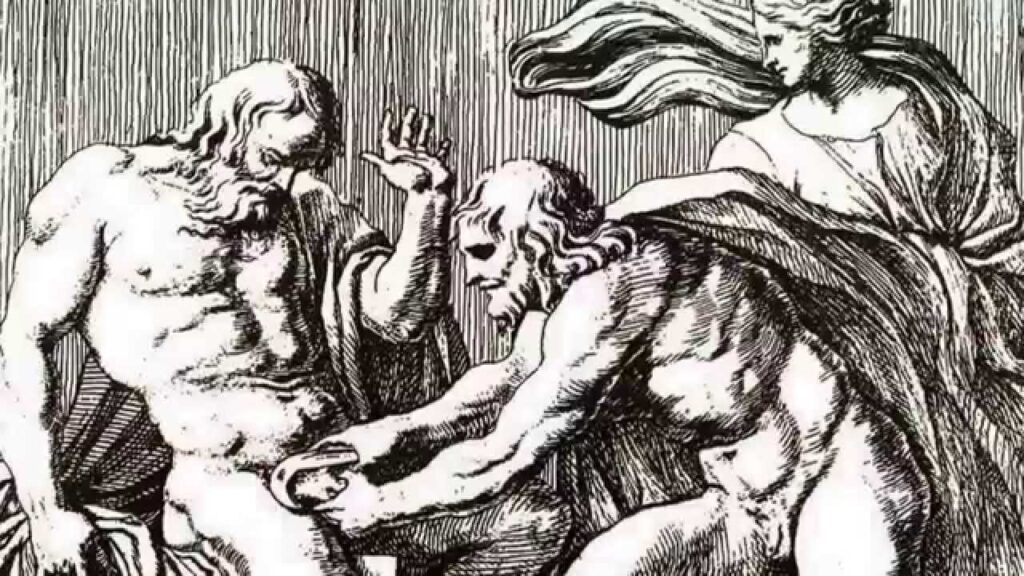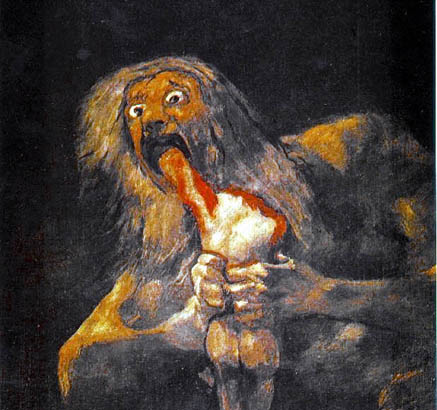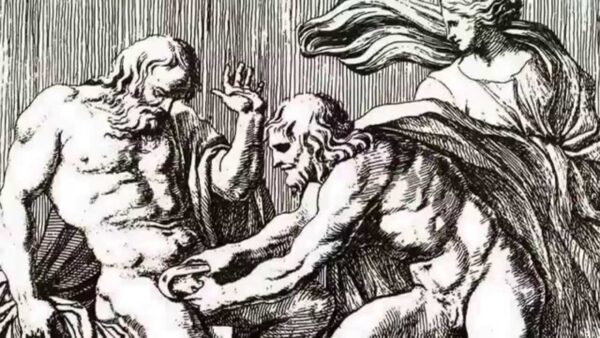Cronos (Saturn)
by Ignazio Caloggero

Origins of the Myth
Cronos (Kronos or Cronus) was considered by the Greeks the youngest son of Uranus (the Sky) and Gaia (the Earth), he was therefore a titan, belonging to the divine generation that preceded the caste of the Olympian gods. At the instigation of his mother, he severed his father's "phallo" with a sickle, which fell to the earth: Aphrodite was born from her blood, while part of it fell on Sicily, making it very fertile ever since. After emasculating his father, Cronos took his place in heaven but Uranus predicted that he would be dethroned by one of his own sons. For this reason, after marrying Rhea (his sister), he devoured his children as they were born. Rhea, pregnant by Zeus and in an attempt to save at least one of her children, fled by secretly giving birth and giving the unsuspecting father, in place of her child, a stone wrapped in diapers. When Zeus grew up, helped by his mother and Metis, one of the daughters of Oceanus, he made Cronos drink a magic potion which forced him to give back all his previously devoured children. These, led by his brother Zeus, declared war on their father and finally managed to defeat him, so Zeus took the place of Cronos in command of the Universe by setting his seat on Olympus.

Madrid, Prado Museum - Francisco de Goya
Saturn devours its children
Cronos was represented with a scythe and, often, also in the company of a crow; in fact, the name Kronos is perhaps related to the Greek word Korone which means crow. It should be noted that the crow has also been associated with Saturn, with whom the Romans identified Cronus, and the Latin term for the crow has a sound similar to the Greek one, that is cornix. Later, perhaps for a play on words, the Greeks themselves wrote, to indicate the divinity, Chronos, which means Time, thus leading us to think that Cronos was the personification of time.
Cronos was identified with the Italian Saturn; Latin mythology narrates that Saturn, after being dethroned by Jupiter (i.e. Zeus), settled on the Campidoglio, in the same place where Rome will rise, founding a village there which took the name of Saturnia. In Rome, in the month of December, the Saturnalia were celebrated, rather licentious feasts in which social differences were made to disappear, even if for a short time; it was not uncommon for the slaves to wear the clothes of the masters and for the latter to serve at the tables.
Cult of Cronos and the places of Sicily
Not much is known about the Cronos cult in Sicily, apart from the fact that he was associated with the Punic cult Baal. It is therefore probable that the Cronus of Sicily, worshiped mainly in the western areas, is actually the incarnation of the god Baal. It is known, in fact, that the ancient Italic god Saturn, when in the imperial era there was a development of Romanization in Sicily and Africa, also embodied the Punic god Baal.
Arm of S. Raineri (Messina) and Promontory of Trapani
These are the places where, the different versions of the myth, drop the "phallo" of Uranus severed by Cronos
Caltabellotta
In Caltabellotta, as evidence of the ancient custom of making human sacrifices in honor of Baal, there is the sacrificial altar (Gogala cliff) dedicated to Cronos which has channels on the sides and where it is assumed that sacrifices still took place in the Greek and Roman periods probably human too.
According to the historian Diodorus Siculus (lib. III.61), Cronos was the king of Sicily, Libya and also of Italy. He established his power over the western regions of Sicily, occupying all the most important hills of the region with garrisons. Precisely for this reason, again according to Diodorus, in Sicily and in other western regions, many mountainous areas were called, from his name, Cronia. Diodorus speaks of a place named Cronio about the defeat suffered by the tyrant of Syracuse, Dionysus, by the Carthaginians in 383 BC
Mount Scuderi (Fiumedinisi, Messina)
Finally, a legend tells that the tomb of Cronos would be found near Monte Scuderi (formerly Monte Saturno).
Marsala and Sciacca
The hypothesis has been formulated that, with the arrival of Christianity, the cult of Cronos was replaced with that of St. Calogero. According to legend, St. Calogero was born in Chalcedon, as a young man, he retired to a forest where he received from God the gift of performing miracles and the ability to prophesy. He then began to preach Christianity, was persecuted and forced, in 303, to exile to Sicily where he lived for many years in a cave in Lillibeo (Marsala), from where he only came out to preach Jesus Christ. In old age he retired to Mount Cronio, not far from Sciacca, later called Mount S. Calogero, where he spent his last days inside a cave [Giuseppe Pitre: Patronal festivities in Sicily. p. 368].
Mount Kronio (Sciacca, Termini Imerese)
The Cronii mountains were more than one and this explains how the S. Calogero mountains are also more than one. Another mountain with the name of San Calogero is found, in fact, near Termini Imerese (precisely between the municipalities of Termini Imerese, Caccamo and Sciara). According to what has been said, the ancient Agrigento belief according to which the saints who respond to the name of Calogero were even four, all brothers who lived as hermits and who eventually became the patron saints of the towns of Agrigento, Sciacca, Licata and Naro [Giuseppe Pitre: Patronal Festivals in Sicily. p. 380].
Signs that suggest the replacement of a pagan divinity with a Christian saint derive from the unfolding, not really Christian, of one of the feasts in honor of St. Calogero. Every year, on the Tuesday after Pentecost, a solemn feast was celebrated on Mount Cronio in honor of the saint, which often degenerated into a real bacchanal. In this regard, Pitre remembers:
".. and even today it is an exhilarating spectacle that of such pilgrims, who have gone with the best religious intentions, and who return too happy, if not drunk ...".
Another interesting element that can be found in the legend of San Calogero is the coincidence, perhaps not entirely by chance, of the fact that the saint, who had the gift of prophecy, lived for a certain period in a cave in Lillibeo, and precisely in a cave of Lillibeo it was the seat of the Sibyl of Lillibeo, the prophetess of Apollo, whose cult was replaced in the Christian era by another prophet, St. John the Baptist.
Cronos and the Genius of Palermo
The Genius of Palermo is considered the secular symbol that represents the civic virtues and identity of the people of Palermo in its different social classes, in a certain sense, for the Palermo people it represents a sort of secular god of happiness and independence and is often put in contrast with Santa Rosalia. He is depicted as a mature man with a split beard, crowned and embraced by a snake feeding on his chest.
An anonymous manuscript, preserved in the Municipal Library of Palermo perhaps from the end of the 500th century puts the Genius of Palermo with Saturn (Cronos) in fact represents the Genius as the representation of "Saturn, god of the earth and of time, father of the times and father of the gods and of men” [Giuseppe La Monica: Mysterious Sicily p. 58]. Another element that relates Cronos to the Genius of Palermo is the phrase "suos devorat, alienos nutrit" ("he devours his children and feeds the foreigners"), engraved on the edge of the basin of the statue of the Genius placed inside Praetorian Palace. In fact, Cronos ate his own children as they were born.
The Myth in the IWB Register of the Sicily Region
The places of the Myth of Cronus – Saturn have been included by the Sicily Region in the LIM Register (Places of Identity and Memory of Sicily), sector of the Places of Myth and Legends.
- Arm of S. Raineri (Messina)
- Mount Kronio (Sciacca-province of Agrigento)
- Kronio Castle, slopes of Monte Pellegrino (Palermo)
- Trapani promontory
- Kronos Altar, Gogala rock (Caltabellotta-prov. Agrigento)
- Mount Scuderi, formerly Monte Saturno (Fiumedinisi-prov. Messina)
To view the places included in the IWB of the Myth of Cronus-Saturn on an Interactive Map, see the following web page: The places of Cronos
Even the places of the Myth of the Genius of Palermo have been included by the Sicily Region in the LIM Register (Places of Identity and Memory of Sicily), sector of Places of Myth and Legends
- Genius of the Molo, marble statue located at the entrance to the port of Palermo on via Emerico Amari. (LIM)
- Genius in Palazzo delle Acquile: The statue is an integral part of the sculpture visible inside the staircase of the Palazzo delle Acquile, seat of the municipality. (LIM)
- Genius in Piazza Garraffo. Sculpture made in the XNUMXth century. It is located in Vucciria, in the central niche of the aedicule built by Paolo Amato in the XNUMXth century.
- Genius in Revolution Square. XNUMXth century sculpture, placed on the fountain in Piazza Revolution. (LIM)
- Genius in the Villa Giulia: marble sculpture from 1778 placed in the fountain of Ignazio Marabittia (LIM)
- Genius in the Palatine Chapel. Above the entrance door of the Palatine Chapel in Palazzo dei Normanni. (LIM)
***
Extract from the Book ” Cults of Ancient Sicily” by Ignazio Caloggero ISBN: 9788832060102 © 2022 Centro Studi Helios srl
The Myth of Cronos is correlated with the Myth of the Genius of Palermo
Card insertion: Ignazio Caloggero
Photo: web
Information contributions: Ignazio Caloggero, Region of Sicily



